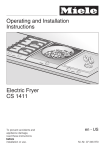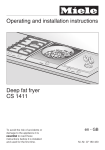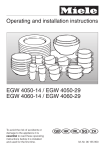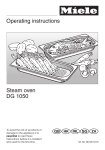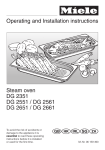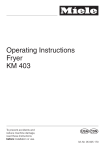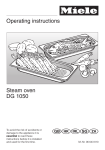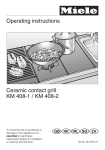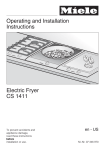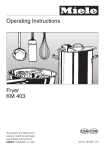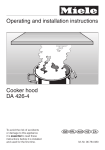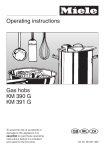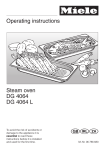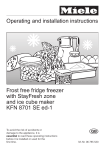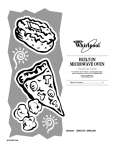Download Miele KM 403 Operating instructions
Transcript
Operating instructions Deep fat fryer KM 403 To avoid the risk of accidents or damage to the appliance it is essential to read these instructions before it is installed or used for the first time. GHirZ M.-Nr. 05 813 370 Contents Description of the appliance . . . . . . . . . . . . . . . . . . . . . . . . . . . . . . . . . . . . . . . . . 3 Warning and Safety instructions . . . . . . . . . . . . . . . . . . . . . . . . . . . . . . . . . . . . . 4 Caring for the environment . . . . . . . . . . . . . . . . . . . . . . . . . . . . . . . . . . . . . . . . . . 9 Before using for the first time . . . . . . . . . . . . . . . . . . . . . . . . . . . . . . . . . . . . . . . 10 General notes . . . . . . . . . . . . . . . . . . . . . . . . . . . . . . . . . . . . . . . . . . . . . . . . . . . . 10 Cleaning and heating up for the first time . . . . . . . . . . . . . . . . . . . . . . . . . . . . . . . 11 Using the fryer . . . . . . . . . . . . . . . . . . . . . . . . . . . . . . . . . . . . . . . . . . . . . . . . . . . 12 Switching on and off . . . . . . . . . . . . . . . . . . . . . . . . . . . . . . . . . . . . . . . . . . . . . . . 12 Before frying . . . . . . . . . . . . . . . . . . . . . . . . . . . . . . . . . . . . . . . . . . . . . . . . . . . . . 12 Frying . . . . . . . . . . . . . . . . . . . . . . . . . . . . . . . . . . . . . . . . . . . . . . . . . . . . . . . . . . . 13 Blanching . . . . . . . . . . . . . . . . . . . . . . . . . . . . . . . . . . . . . . . . . . . . . . . . . . . . . . . . 13 Frying tips . . . . . . . . . . . . . . . . . . . . . . . . . . . . . . . . . . . . . . . . . . . . . . . . . . . . . . . 16 After frying . . . . . . . . . . . . . . . . . . . . . . . . . . . . . . . . . . . . . . . . . . . . . . . . . . . . . . . 17 Safety cut-out switch . . . . . . . . . . . . . . . . . . . . . . . . . . . . . . . . . . . . . . . . . . . . . . . 18 Cleaning and care . . . . . . . . . . . . . . . . . . . . . . . . . . . . . . . . . . . . . . . . . . . . . . . . 19 General notes . . . . . . . . . . . . . . . . . . . . . . . . . . . . . . . . . . . . . . . . . . . . . . . . . . . . 19 E-Cloth . . . . . . . . . . . . . . . . . . . . . . . . . . . . . . . . . . . . . . . . . . . . . . . . . . . . . . . . . . 19 Frying basket . . . . . . . . . . . . . . . . . . . . . . . . . . . . . . . . . . . . . . . . . . . . . . . . . . . . . 20 Oil reservoir . . . . . . . . . . . . . . . . . . . . . . . . . . . . . . . . . . . . . . . . . . . . . . . . . . . . . . 20 Stainless steel surround. . . . . . . . . . . . . . . . . . . . . . . . . . . . . . . . . . . . . . . . . . . . . 21 Glass control panel . . . . . . . . . . . . . . . . . . . . . . . . . . . . . . . . . . . . . . . . . . . . . . . . 21 Lid . . . . . . . . . . . . . . . . . . . . . . . . . . . . . . . . . . . . . . . . . . . . . . . . . . . . . . . . . . . . . 21 Problem solving guide. . . . . . . . . . . . . . . . . . . . . . . . . . . . . . . . . . . . . . . . . . . . . 22 Electrical connection . . . . . . . . . . . . . . . . . . . . . . . . . . . . . . . . . . . . . . . . . . . . . . 23 Electrical connection . . . . . . . . . . . . . . . . . . . . . . . . . . . . . . . . . . . . . . . . . . . . . . . 23 After sales service . . . . . . . . . . . . . . . . . . . . . . . . . . . . . . . . . . . . . . . . . . . . . . . . 25 Data plate . . . . . . . . . . . . . . . . . . . . . . . . . . . . . . . . . . . . . . . . . . . . . . . . . . . . . . . 25 2 Description of the appliance a Lid i Drain tap b Frying basket j Control (red dot: 170 °C) c Handle (fold-away, removable) k Oil reservoir (capacity: min. 3.0 litres, max. 4.0 litres) d Hanging facility e Basket hanging support f Heating element (can be raised up; rating - 2700 W) g Temperature indicator light h Operating indicator light l Mains connection cable m Plug Depending on country of destination, the appliance may be supplied with or without a plug. The plug shown is for illustration only. 3 Warning and Safety instructions Building in and connection This appliance complies with all relevant legal safety requirements. Improper use of the appliance can, however, present a risk of both personal injury and material damage. To avoid the risk of accidents and damage to the appliance, read these instructions carefully before using it for the first time. They contain important notes on the installation, safety, operation and care of the appliance. Keep these instructions in a safe place for reference and pass them on to any future user. If the appliance is supplied without a plug, or if the plug is removed, it must be connected to the mains electricity supply by a suitably qualified and competent electrician in strict accordance with local and national safety regulations. The manufacturer cannot be held liable for damage caused by incorrect installation or connection. The electrical safety of this appliance can only be guaranteed when continuity is complete between it and an effective earthing system which complies with local and national safety regulations. It is most important that this basic safety requirement is present and tested regularly, and where there is any doubt, the household wiring system should be inspected by a qualified electrician. The manufacturer cannot be held liable for the consequences of an inadequate earthing system (e.g. electric shock). Do not connect the appliance to the mains electricity supply by an extension lead. Extension leads do not guarantee the required safety of the appliance (e.g. danger of overheating). This equipment may only be used in mobile installations such as ships, caravans, aircraft etc. if a risk assessment of the installation has been carried out by a suitably qualified engineer. 4 Warning and Safety instructions Correct usage For safety reasons this appliance must only be operated after it has been built in. This is necessary to ensure that all electrical components are shielded. This appliance is intended for domestic use only and is not to be used for commercial purposes. Use this appliance for the preparation of food only. Any other usage is at the owner's risk and could be dangerous. The manufacturer cannot be held liable for damage caused by incorrect or improper use of the appliance. Do not use the appliance to heat up the room and never switch it on with the heating element in the raised position. Due to the high temperatures radiated, objects near the appliance could catch fire. The life of the appliance could also be reduced. This appliance must not be set up or operated in the open air. This appliance should only be switched on when the lid has been taken off and it has been filled with oil. Handling and preparing food correctly is essential for maintaining good health. Please read the "Frying tips" section in "Using the fryer" later on in this booklet. 5 Warning and Safety instructions Safety with children The appliance is only intended for use by adults who have read these operating instructions. This appliance is not a toy! To avoid the risk of injury keep children well away and do not let them play with it or use the controls. They will not understand the potential dangers posed by it. They should be supervised whenever you are working in the kitchen. Older children may use the appliance only when its operation has been clearly explained to them, and they are able to use it safely, recognising the dangers of misuse. Supervise its use by the elderly or infirm. The appliance gets hot when in use and remains hot for quite a while after being switched off. To safeguard against burning, keep children well away from the appliance at all times. Do not store anything which might arouse a child's interest in storage areas above or next to the appliance. Otherwise they could be tempted into climbing onto the appliance with the risk of burning themselves. 6 To prevent the risk of children burning themselves with potentially hot fat or oil please make sure that they cannot access the drain tap and open it. Packaging, e.g. cling film, polystyrene and plastic wrappings must be kept out of the reach of babies and young children. Danger of suffocation. Dispose of or recycle all packaging safely as soon as possible. Old appliances must be disconnected from the power supply, any plug rendered useless and the cable cut off directly behind the appliance to ensure it presents no danger to children while being stored for disposal. Warning and Safety instructions Protecting the appliance from damage Protection from burning and scalding Do not drop anything on the glass surface. Even a light object could cause damage in certain circumstances. Never leave the appliance unattended when using it. Overheated oil can catch fire and could even set the cooker hood on fire. Never use open flames near the appliance, e.g. candles or lighters. Fire hazard! Do not use a steam cleaner to clean this appliance. The steam could reach electrical components and cause a short circuit. Pressurised steam could also cause permanent damage to the surface and to other components, for which the manufacturer cannot accept liability. In countries where there are areas which may be subject to infestation by cockroaches or other vermin, pay particular attention to keeping the appliance and its surroundings in a clean condition at all times. Any damage which may be caused by cockroaches and other vermin will not be covered by the appliance guarantee. If frying oil does catch fire despite this do not attempt to put out the flames with water. Stifle the fire with a suitable fire blanket or by covering with the lid. Avoid touching the appliance and the frying oil when they are hot. Both will remain hot for quite a while after the appliance has been switched off. Only the handle of the frying basket can be touched safely. For added protection, it is advisable to use heat-resistant pot holders or gloves when using the appliance. Do not let them get damp or wet, as this causes heat to transfer through the material more quickly with the risk of burning yourself. Clean or change dirty oil or fat in good time. Oil or fat containing impurities is liable to catch fire. 7 Warning and Safety instructions Appliance faults Further safety notes In the event of damage or a defect, switch off the appliance immediately. Disconnect completely from the electricity supply. If the appliance has not yet been fully installed, the electricity cable must be disconnected from the supply point. If connected via a plug and socket, switch off at the socket and withdraw the plug. Contact the Service Department. Do not reconnect the appliance to the mains electricity supply until after it has been repaired. When using an electric socket near the appliance, care should be taken that the cable of the electrical appliance does not come into contact with the hot appliance. The insulation on the cable could become damaged, giving rise to an electric shock hazard. If there is any damage to the glass surface the appliance must be disconnected from the mains electricity supply immediately and not used until it has been repaired. Danger of electric shock. Repairs must only be carried out by a suitably qualified and competent person. Repairs and other work by unqualified persons could be very dangerous and could damage the appliance. The manufacturer cannot be held liable for unauthorised work. Never open the housing of the appliance. While the appliance is under guarantee, repairs should only be undertaken by a service technician authorised by the manufacturer. Otherwise the guarantee is invalidated. 8 Always ensure that food is sufficiently cooked or reheated. Many factors will affect the overall cooking time, including the size and amount of food and its temperature. Some foods may contain micro-organisms which are only destroyed by thorough cooking; therefore when cooking or reheating foods such as poultry, it is particularly important that the food is completely cooked through. If in doubt, select a longer cooking or reheating time. Never use plastic containers for hot fat. These melt at high temperatures. Do not dispose of used cooking oil down the sink. It can damage pipework and cause blockages in the water pipes. Dispose of it safely with your household waste or ask your local authority about disposal schemes in your area. The manufacturer cannot be held liable for damage caused by non-compliance with these Warning and Safety instructions. Caring for the environment Disposal of packing material Disposal of your old appliance The transport and protective packing has been selected from materials which are environmentally friendly for disposal and can normally be recycled. Electrical and electronic appliances often contain materials which, if handled or disposed of incorrectly, could be potentially hazardous to human health and to the environment. They are, however, essential for the correct functioning of your appliance. Please do not therefore dispose of your old appliance with your household waste. Packaging, e.g. cling film, polystyrene and plastic wrappings must be kept out of the reach of babies and young children. Danger of suffocation. Dispose of or recycle all packaging materials as soon as possible. Please dispose of it at your local community waste collection / recycling centre and ensure that it presents no danger to children while being stored for disposal. It should be unplugged or disconnected from the mains electricity supply by a competent person. The plug must be rendered useless and the cable cut off directly behind it to prevent misuse. 9 Before using for the first time General notes Please stick the extra data plate for the appliance supplied with this documentation in the space provided in the "After sales service" section of this booklet. 10 Before using for the first time Cleaning and heating up for the first time Before using the fryer for the first time clean it as follows: ^ Fill the oil reservoir with approx. 4 litres of water and add a little washing up liquid. Ensure that the water level is not higher than the maximum level indicator which is marked at the back of the reservoir. Metal components have a protective coating which may give off a slight smell when heated up for the first time. The smell and any vapours will dissipate after a short time and do not indicate a faulty connection or appliance. ^ Turn the control in a clockwise direction to 130 °C and bring the water to the boil. ^ When the water has started to boil, switch off the fryer by turning the control back anti-clockwise to "0". Empty the water through the drain tap into a heat resistant container (see "After frying"). ^ Rinse the oil reservoir out with hot water. ^ Close the drain tap, raise the heating element and dry the reservoir with a clean cloth. ^ Clean all other appliance surfaces with a damp cloth only, and then wipe dry. 11 Using the fryer Switching on and off Before frying To switch the fryer on, turn the control in a clockwise direction a. To switch off, turn the control anti-clockwise b to "0". Before frying make sure that the oil reservoir has been filled with enough frying oil or fat (min. 3 litres / 3 kg, max. 4 litres / 4 kg). You cannot turn the control to "0" by turning it past 200 °C. Only use oil / fat which is suitable for frying in and which can be heated to a high temperature. Never mix different types of Oil / fat together. Proceed as follows: ^ Make sure the drain tap is closed. ^ Fill the oil reservoir with oil / fat. Solid fat should be cut up into small pieces first. When re-using fat which has solidified in the reservoir, make a hole in the solid fat as far as the element. This allows any water which has gathered under the fat to evaporate. When the appliance is switched on, the temperature indicator light g and the operating indicator light h come on. The temperature indicator light tacts on and off in conjunction with the heating element. Only operate the fryer without the lid. Never switch it on when it is empty or when the heating element is raised up. 12 ^ Turn the control to 100 °C and wait until the fat has melted. ^ When all the fat has melted check the level in the reservoir. This needs to be between the minimum and maximum level indicators at the back of the reservoir. Using the fryer Frying Proceed as follows: ^ Set the frying temperature required (see chart) and wait until the temperature indicator light goes out for the first time. The oil has now reached the set temperature. ^ Carefully lower the frying basket containing the food to be fried into the hot oil. If the oil froths a lot, lift the basket out of the oil briefly and then slowly lower it into the hot fat again. ^ When the food is cooked, lift the basket out of the hot oil. Shake the basket a little to remove any excess oil, and then hang it on its support. Do not leave food suspended over the reservoir for too long as steam from the oil can cause the food to lose its crispness. Finally, place the food onto kitchen paper towel to soak up any remaining excess oil. Warning. Whilst frying food make sure you to not touch the hot oil. Protect you hands in particular, for instance by wearing heat resistant oven gloves. Blanching It is also possible to use this appliance for blanching vegetables by using water instead of oil or fat. 13 Using the fryer Food (fresh) Quantity Temperature* in °C Frying time in minutes Breaded chicken portions 2 x 250 g pieces 170 8-10 Unbreaded turkey steaks 2 x 250 g pieces 180 3-5 Cumberland sausages 4 170 7-8 Camembert 4 pieces 170 2-3 Raw battered vegetables 400 g 170 7-9 Raw battered mushrooms 400 g 170 2-3 Saute potatoes 400 g 170 2-3 Croquette potatoes 400 g 170 pre-frying 2-4 frying 3-5 Fried bread 500 g 200 30 secs - 1 min Chips 400 g 170 pre-frying 4-6 frying 2-4 Crisps 400 g 170 3-5 Jam doughnuts 4 pieces 170 6-8 Pineapple fritters 2 pieces 170 2-3 Banana fritters 2 pieces 170 3-4 * The temperature setting for 170 °C is marked with a red dot. Please note: The times given are only a guide. The actual cooking times will depend on the size and quantity of food cooked. 14 Using the fryer Food (frozen) Quantity Temperature* in °C Frying time in minutes Fish fingers 300 g 170 4-6 Beef burgers 220 g 170 5-6 Croquette potatoes 400 g 170 pre-frying 1-2 frying 3-4 Chips 250 g 400 g 170 2-3 3-4 2 x 60 g 170 8-10 Scampi 250 g 170 4-5 Unbreaded plaice fillets 300 g 170 3-5 Squid rings 250 g 180 2-3 Spring rolls * The temperature setting for 170 °C is marked with a red dot. Please note: The times given are only a guide. The actual cooking times will depend on the size and quantity of food cooked. 15 Using the fryer Frying tips Handling and preparing food correctly is essential for maintaining good health. Food should be fried until it is golden brown. Do not let it get too dark. Never add salt to food in hot fat. This could cause the fat to boil over. – The oil or fat needs to be hot enough to seal the food quickly. If the temperature is too low the food will absorb too much fat, making it difficult to digest. It is important to wait until the temperature indicator goes out (which means the set temperature has been reached), before adding food to the fryer. – Best results are achieved by keeping to the temperature guidelines given in the chart. Only use temperatures above 170 °C where absolutely necessary (e.g. for fish and meat which has not been coated in breadcrumbs or pastry). – When frying deep frozen products use the lowest temperature quoted on the manufacturer’s packaging. 16 – Keep frying times as short as possible. – Use the correct ratio of food to fat. This should be between 1:10 and 1:15. For example with a minimum fill of 3 litres of oil you can cook about 300 g of frozen chips. Food will get too hot if you use too much oil. If you try and fry too much food at once the oil will cool down too much. – Heating the oil for too long will speed up its deterioration rate. – Food should be as dry as possible for frying. Moisture can cause frothing. Damp food should be dried using paper towel. Remove any excess ice and frost from deep frozen food. – Lower the frying basket slowly so that the oil does not froth over. – Rinsing freshly cut potatoes under running water and then drying them thoroughly with kitchen paper towel will prevent them sticking together. – Items containing yeast should be placed in the fat with the risen side downwards and turned over half way through cooking. – Never season food before frying it. Salt, seasoning, icing sugar, etc. should be added after the food has been removed from the basket and drained of excess fat. Using the fryer After frying Switch the fryer off and filter the oil. This not only removes impurities which can affect the taste of the food, but will help the oil last longer. Proceed as follows: ^ Allow the oil to cool down, but not to solidify. If it has solidified it can be melted by heating the fryer up to 100 °C. ^ Place a heat resistant container of a suitable size, e.g. a metal pan, beneath the drain tap under the appliance. ^ Open the drain tap by turning it anti-clockwise a as far as it will go. ^ After the oil has drained out, close the tap by turning it clockwise b as far as it will go. Check that you cannot turn it any further. ^ Filter the oil by pouring it through kitchen paper or a metal sieve lined with kitchen or filter paper and store it in a closed heat-resistant container until it is needed again. Make sure that the drain tap under the appliance is always easy to access for draining. Make sure the oil has cooled down sufficiently before draining it. If it is too hot there is a risk of burning and scalding. Make sure the container you use for draining the oil into is heat-resistant and cannot melt. After using the fryer do not replace the lid until the appliance has cooled down. The oil must be replaced if it – is very dark and thick – smells unpleasant and froths – begins to smoke at a temperature of 170 °C or less. 17 Using the fryer Safety cut-out switch Your fryer is fitted with a safety cut-out which automatically switches it off if: – the oil reservoir is not filled to at least the lower level indicator. – the fryer is switched on when empty. – the fryer is switched on when the heating element has been raised (e.g. for cleaning). The fryer has cut out automatically when neither the temperature indicator light nor the operating indicator light is on and the oil is no longer being heated. 18 ^ Turn the control to "0" and wait until the heating element has cooled down. ^ Rectify whatever has caused the automatic cut-out. ^ Press the pin (see arrow) which is on the left rear underside of the fryer in firmly. The fryer can now be used again. Cleaning and care General notes Clean the appliance regularly, preferably after each use. Allow the appliance to cool down to a safe temperature before cleaning. Do not use a steam cleaner to clean this appliance. The steam could reach the electrical components and cause a short circuit. Pressurised steam could also cause permanent damage to the surface and to components for which the manufacturer cannot accept liability. Do not use any sharp objects which could damage the seal between the glass surface and the surrounding frame and between the frame and the worktop. Do not use any of the following as they can damage the surface: cleaning agents containing sand, soda, alkalines, acids or chlorides, grill and oven sprays, dishwasher cleaner, stain or rust removers, scouring agents or cream cleaners, abrasive sponges and brushes. When using cleaning agents for stainless steel and glass surfaces you must follow the manufacturers instructions on the packaging. Important: Do not use stainless steel cleaning agents inside the oil reservoir! Always dry the appliance thoroughly with a soft cloth after cleaning it with water or a damp cloth. This prevents a build-up of limescale deposits. E-Cloth A microfibre "E-Cloth" is available from the Miele UK Spare Parts Department, which is suitable for cleaning surfaces such as stainless steel, glass, plastic and chrome without the use of chemicals. 19 Cleaning and care Frying basket Oil reservoir After each use, clean the frying basket by hand with hot water and a little washing up liquid and then dry it thoroughly. It is best to soak stubborn soiling before cleaning. The handle can be removed for cleaning. ^ Drain the oil out of the reservoir before cleaning (see "After frying"). Then raise the heating element. The frying basket must not be washed in a dishwasher. ^ Use kitchen paper towel to remove any large particles. ^ Fill the reservoir to the maximum mark with a solution of hot water and washing up liquid and wash out thoroughly. ^ Drain the suds solution into a suitable container and then clean the drain outlet with a bottle brush. Finally rinse the reservoir out with hot water and and then dry both the reservoir and the drain outlet thoroughly. Do not use cleaning agents for stainless steel in the oil reservoir. 20 Cleaning and care Stainless steel surround Glass control panel Clean the stainless steel surround with hot water and a little washing up liquid applied with a soft sponge. Wipe dry using a soft cloth. Soak stubborn soiling first to loosen it. Clean the glass surface and control with a damp cloth only, and then wipe dry with a soft cloth. The stainless steel surround can be cleaned using a Miele E-Cloth or a proprietary non-abrasive cleaning agent designed specifically for use on stainless steel. To help prevent re-soiling, a proprietary conditioning agent for stainless steel, such as Neoblank (available from the Miele Spare Parts Department) can also be used. Follow the manufacturer's instructions on the label and apply sparingly with an even pressure following the direction of the grain. If wished, you can use a few drops of a proprietary glass cleaning agent afterwards. Please follow the manufacturer’s instructions. Lid Clean the lid with hot water and a little washing up liquid applied with a soft sponge, and then wipe dry with a soft cloth. Note: Please take care when cleaning the lid as it scratches easily. 21 Problem solving guide ... the oil has an unpleasant odour. Repairs to electrical appliances must only be carried out by a suitably qualified and competent person in strict accordance with current local and national safety regulations. Unauthorised repairs could be dangerous. The manufacturer cannot be held liable for unauthorised work. However, some minor problems can be resolved as follows: What to do if, ... ... after switching on, the appliance does not heat up. Check whether – the safety cut-out has been activated (see "Safety cut-out switch"). – the appliance has been switched on at the mains and that the mains fuse is in order. If the fuse has blown, contact an electrician or the Service Department. 22 Check whether the oil – is suitable for frying. – needs changing. ... the food is not crisp and brown. Ensure that the oil is hot enough and that the frying basket is not overloaded. Fry for longer if necessary. Electrical connection Electrical connection All electrical work should be carried out by a suitably qualified and competent person in strict accordance with current national and local safety regulations (BS 7651 in the UK). Installation, repairs and other work by unqualified persons could be dangerous. The manufacturer cannot be held liable for unauthorised work. Ensure power is not supplied to the appliance until after installation or repair work has been carried out. The appliance must only be operated when built-in. This is to ensure that all electrical parts are shielded. Live parts must not be exposed. Do not connect the appliance to the mains electricity supply by an extension lead. These do not guarantee the required safety of the appliance. The voltage and connected load are given on the data plate. Ensure that these match the household mains supply. Connection should be made via a suitable isolator or a double pole fused spur connection unit which complies with national and local safety regulations and the on/off switch should be easily accessible after the appliance has been built in. If the switch is not accessible after installation (depending on country) an additional means of disconnection must be provided for all poles. For extra safety it is advisable to install a residual current device (RCD) with a trip current of 30 mA. When switched off there must be an all-pole contact gap of 3 mm in the isolator switch (including switch, fuses and relays). Important U.K. This appliance is supplied for connection to a single phase 230-240 V 50 Hz supply with a 3-core cable. The wires in the mains lead are coloured in accordance with the following code: Green/yellow = earth Blue = neutral Brown = live WARNING THIS APPLIANCE MUST BE EARTHED 23 Electrical connection Important The electrical safety of this appliance can only be guaranteed when continuity is complete between the appliance and an effective earthing system, which complies with local and national regulations. It is most important that this basic safety requirement is present and tested regularly and if there is any doubt the electrical wiring in the home should be inspected by a qualified electrician. The manufacturer cannot be held liable for the consequences of an inadequate earthing system such as an electric shock. The manufacturer cannot be held liable for damage which is the direct or indirect result of incorrect installation or connection. 24 After sales service In the event of any faults which you cannot remedy yourself, please contact – Your Miele Dealer or – The Miele Service Department (see address on back cover). When contacting the Service Department, please quote the model and serial number of your appliance. These are given on the data plate. Please note that telephone calls may be monitored and recorded for training purposes. Data plate Space in which to stick the extra data plate supplied with the appliance. Ensure that the model number is the same as the one on the front of these operating instructions. 25 26 27 Alteration rights reserved / 4505 M.-Nr. 05 813 370 / 08 en - –




























